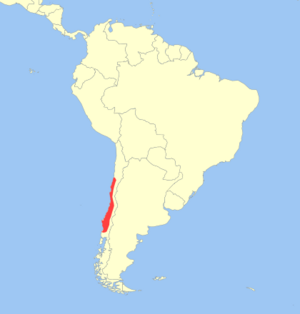Elegant fat-tailed mouse opossum facts for kids
Quick facts for kids Elegant fat-tailed mouse opossum |
|
|---|---|
 |
|
| Conservation status | |
| Scientific classification | |
| Genus: |
Thylamys
|
| Species: |
elegans
|
 |
|
| Range of the elegant fat-tailed mouse opossum | |
| Synonyms | |
|
Didelphis elegans Waterhose, 1839 |
|
The elegant fat-tailed mouse opossum (Thylamys elegans), also known as the Chilean mouse opossum, is a small opossum found in central Chile. It was first described by an English scientist named George Robert Waterhouse in 1839.
This medium-sized opossum has black rings around its eyes, white legs, and a coat that can be gray or light brown. Its sides and belly are lighter in color. It has a thick tail, about 12.7–14.6 centimetres (5.0–5.7 in) long, covered with hair.
These opossums are most active around dawn and dusk, which is called being crepuscular. They live in nests found in tree hollows or under rocks and roots. They mostly eat arthropods (like insects and spiders) and their young (larvae), but also enjoy fruits. A mother opossum usually has between 11 and 13 babies at a time.
The elegant fat-tailed opossum can live in many different places, from cloud forests (forests often covered in clouds) to chaparrals (areas with dense shrubs). The IUCN (International Union for Conservation of Nature) says this opossum is of least concern, meaning it's not currently in danger of disappearing.
Contents
What's in a Name?
The elegant fat-tailed mouse opossum belongs to a group of animals called Thylamys. It is part of the Didelphidae family, which includes all opossums.
The first scientific name given to this animal was Didelphis elegans in 1839 by George Robert Waterhouse. Later, in 1843, another English scientist named John Edward Gray gave it its current scientific name, Thylamys elegans.
The name Thylamys comes from two Greek words: thylas, meaning "pouch," and mys, meaning "mouse." The word elegans is Latin for "elegant." So, its name means "elegant pouch-mouse"!
People also call this opossum by other names, like Chilean mouse opossum, comadreja, llaca, marmosa chilena, marmosa elegante, and yaca.
How to Spot Them
The elegant fat-tailed mouse opossum is a medium-sized opossum. It has white legs, and its fur can be gray or light brown. Its sides and belly are usually lighter. A cool feature is the black ring around each eye, which extends a little bit towards its nose. The color of its fur can change depending on where it lives.
Its tail is thick and covered with hair, measuring about 12.7–14.6 centimetres (5.0–5.7 in) long. The tail can get even thicker if the opossum stores fat in it, sometimes reaching 1 centimetre (0.39 in) around the body. Its head and body together are about 11–13.7 centimetres (4.3–5.4 in) long. Its back feet are about 1.7 centimetres (0.67 in), and its ears are about 2.3 centimetres (0.91 in).
These opossums can go into a state called torpor. This is like a short nap that helps them save energy and food, especially when it's cold or food is scarce. It's similar to hibernation, but it only lasts for a short time. Also, if there's not much water around, their bodies can make their urine very concentrated to save water.
Life and Habits
The elegant fat-tailed mouse opossum is crepuscular, meaning it is most active during twilight hours (dawn and dusk). It makes its home in nests that birds or rodents have left behind, or it builds its own. These nests are often found in hollow trees, under rocks, or among tree roots.
This opossum spends time both in trees (it's arboreal) and on the ground (it's terrestrial). Its main diet includes arthropods (like insects and spiders) and their larvae. But it also eats fruits, small vertebrates (animals with backbones), and even dead animals (carrion).
The opossum has a special tail that can grab onto branches, helping it climb very well. This is called a prehensile tail. Even if its tail is thick with stored fat, it can still use it to climb efficiently. This skill is not as strong in other small Chilean mammals.
Usually, only one opossum lives in a nest. In southern Chile, an opossum's home range (the area it uses for living) can be about 1,383 square metres (14,890 sq ft) in July, but it shrinks to about 781 square metres (8,410 sq ft) in December. Animals that hunt this opossum include the culpeo fox, the burrowing owl, and the great horned owl.
Reproduction and Life Cycle
Both male and female elegant fat-tailed mouse opossums are ready to have babies by the time they are one year old. A female can have one or two litters (groups of babies) during the breeding season, which usually runs from September to March.
She can produce up to 17 embryos (developing babies), but the number of babies that survive depends on how many nipples she has that are working. Typically, a mother opossum has 11 to 13 working nipples, so she usually raises that many babies.
Where They Live and Their Status
The elegant fat-tailed mouse opossum lives in many different places. You can find them in cloud forests and chaparrals, up to about 2,500 metres (8,200 ft) above sea level. They live west of the Andes mountains in central Chile.
The IUCN says this opossum is of least concern. This means they are not worried about it becoming extinct because it lives in a wide area and there are many of them. However, in some places, cutting down forests (deforestation) and expanding farms (agricultural expansion) have caused the number of opossums to go down.


